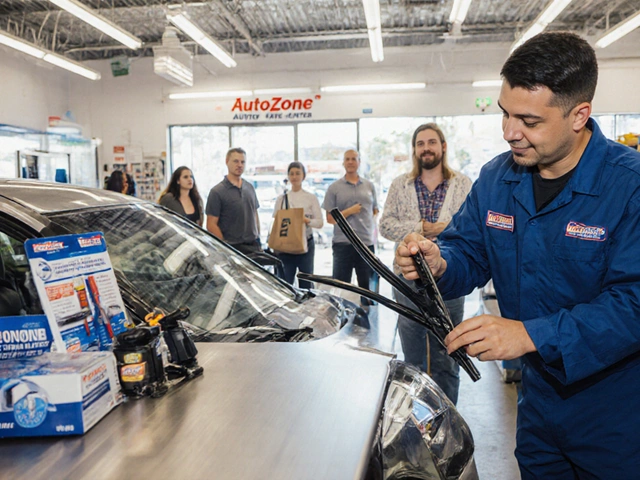If your brakes are acting up, it’s not something to brush aside. Bad rotors are one of those car problems people hope will just go away, but here’s the bottom line—they won’t. Your rotors are those flat, round metal discs behind your wheels, and they work with your brake pads to slow you down every time you step on the pedal. When they’re shot, your stopping power drops big time.
You might be thinking, “My car still stops, so do I really need to fix this now?” Truth is, even if it feels okay in the moment, worn rotors can lead to expensive damage fast. Messed up rotors not only mess with how fast you can stop, but they can also make your stopping distance a lot longer—sometimes by several car lengths. That’s risky in a split-second emergency.
Don’t ignore those weird sounds, shaky steering, or that pulsating brake pedal. I’ll break down exactly what those signs mean, what happens if you keep driving, and the smart moves you can make to avoid a bigger repair bill down the road. Let’s get real about what your brakes are telling you and what you should actually do next.
- What Do Rotors Actually Do?
- Warning Signs Your Rotors Are Bad
- How Bad Rotors Really Affect Driving
- What Happens If You Ignore the Problem?
- What to Do If You Suspect Bad Rotors
- Tips for Preventing Future Brake Trouble
What Do Rotors Actually Do?
Rotors are the metal discs you see behind your wheels. When you press your brake pedal, your car’s brake pads clamp down on these rotors. That friction is what actually slows the wheels, bringing your car to a stop. Think of rotors as the main part that helps your car “grab the road” when you want to stop.
Here’s what really happens:
- You hit the brake pedal.
- Brake fluid moves through the lines, pushing the brake calipers.
- Those calipers squeeze the brake pads against the rotors.
- The friction between pads and rotors slows down or stops the wheel.
It sounds simple, but those rotors take tons of force and heat—sometimes over 400°F during hard stops. If you drive a heavier vehicle or tow stuff, rotors work even harder. That’s why they’re made from tough materials like cast iron or steel.
The bad rotors problem kicks in when these discs get too thin, glazed, warped, or grooved. Even a small warp (like just 0.002 inches) can lead to shaky brakes and lousy stopping distance. Here’s a look at some real-world data:
| Condition | Impact on Stopping Distance |
|---|---|
| Normal rotors | Standard stopping distance (as designed) |
| Warped rotors | Increase by 10-20% |
| Severely worn rotors | Increase up to 40% |
So, if your car usually needs 100 feet to stop, warped rotors could stretch that to 120 feet, and badly worn rotors might push it to 140 feet. That extra space can be the difference between a near-miss and a fender bender—or worse.
Keeping your rotors in good shape isn’t only about smooth stops. It keeps everything in your brake system working right, and it helps your brake pads last longer too. If your brakes are noisy, bumpy, or just don’t feel right, always check the rotors—not just the pads.
Warning Signs Your Rotors Are Bad
Your car won’t just quietly let you know when something’s off with your rotors. In fact, it usually makes a scene. Signs of bad rotors aren’t exactly subtle, but a lot of people don’t realize what to watch for until it’s too late. Here’s what to keep an eye (or ear) out for.
- Squeaking or Squealing Noises: You know that high-pitched squeal you keep hearing when you brake? That’s not normal. It’s usually your first clue your rotors or brake pads are crying out for help.
- Grinding Sounds: If you hear grinding, metal-on-metal type sounds, it often means your brake pads have worn all the way down, and now your rotors are taking the hit. This is when repairs get expensive fast.
- Vibration or Pulsing: If your steering wheel starts shaking or you feel pulsing through the brake pedal whenever you slow down, odds are your rotors are warped or uneven.
- Longer Stopping Distances: Notice your car needs more space to stop than it used to? That extra time is a sign something’s up with your brakes, usually the rotors.
- Visible Wear or Grooves: If you check your rotors and spot grooves, scoring, or weird blue spots (from heat), don’t ignore it. That’s real physical damage.
Some shops have even reported that nearly 30% of cars coming in for brake service have rotors below minimum thickness. Here’s a quick comparison of rotor health and symptoms:
| Rotor Condition | Common Symptoms | Risk Level |
|---|---|---|
| Good | Smooth, quiet braking | Low |
| Worn/Thin | Squealing, longer stops | Medium |
| Warped/Scored | Pulsing pedal, shaking wheel | High |
| Severely Damaged | Grinding, weak stopping | Very High |
The best tip? Don’t wait for the grinding or violent shaking stage. The sooner you tackle any of these signs, the cheaper and safer your fix will be.
How Bad Rotors Really Affect Driving
Driving with bad rotors isn’t just a minor hassle—it messes with your car’s ability to stop safely and smoothly. When rotors get worn out or warped, they don’t grab the brake pads properly. That can make your car shake when you brake, give you a weird pulsing feeling in the pedal, or even cause some scary screeching and grinding sounds. None of these are normal, and they always mean less stopping power.
Every time you hit the brake, your car relies on friction between the pads and those rotors. If they’re scored or wobbly, parts of the pad might not touch at all, so stopping takes longer. According to a study by the National Highway Traffic Safety Administration, brake system problems (including rotors) are a factor in roughly 22% of all vehicle crashes with mechanical causes in the US. That’s no small number.
Here’s what you might notice with bad rotors:
- Steering wheel or pedal shakes when braking (not just annoying—it’s a warning!)
- Noisy stops: squealing, grinding, or metal-on-metal sounds
- Longer stopping distances, especially in panic situations
- Uneven brake pad wear, making future repairs pricier
- Burning smells after heavy braking (heat from metal friction—never a good sign)
“Rotors that are scored, warped, or below minimum thickness don’t just reduce stopping performance—they could mean your brakes fail when you need them most,” says the Car Care Council.
| Issue | What You’ll Feel | How It Impacts Driving |
|---|---|---|
| Warped Rotors | Pulsing brake pedal | Hard to stop smoothly, longer braking distance |
| Scored Rotors | Grinding/squealing sounds | Reduces grip, damages new brake pads |
| Overheated Rotors | Burning smell, soft pedal | Brake fade (less stopping power until it cools) |
Ignore this stuff and you’re rolling the dice with your safety. Worn rotors put extra stress on your brake system, so you could end up replacing not just rotors, but also pads, calipers, and maybe even tires if things get out of hand.

What Happens If You Ignore the Problem?
If you put off fixing bad rotors, you’re basically gambling with your safety and your wallet. Worn or warped rotors make it way harder for your brake pads to grip, so your car needs more distance to stop. This means you’re at a higher risk for fender benders or even serious accidents—especially if you need to slam the brakes in traffic.
The damage doesn’t stop with the rotors. When rotors get too thin or uneven, your brake pads break down way faster than normal. If things get really bad, the metal-on-metal contact can wreck your calipers, which are expensive to replace. It’s like a domino effect: one ignored problem creates two new ones.
"Driving with bad rotors is one of the quickest ways to turn a simple brake job into a full brake system replacement," warns the National Highway Traffic Safety Administration (NHTSA).
Let’s get real about how quickly things can get out of hand. Here’s what you might face if you keep putting off repairs:
- Louder grinding or squealing noises every time you brake
- Longer stopping distance (sometimes double what it should be)
- Steering wheel shakes, especially when slowing down
- Brake failure in extreme cases—yep, it’s happened
- Much higher repair costs down the line
Check out this quick breakdown of how ignoring bad rotors can hit your wallet and safety:
| Issue | Typical Cost | Extra Safety Risk |
|---|---|---|
| Bad Rotors (replace right away) | $250 - $500 | Longer stopping, mild risk |
| Pad + Rotor Damage | $400 - $800 | Greater chance of an accident |
| Caliper Damage or Brake Failure | $700 - $1200+ | Can’t stop safely, high risk |
The bottom line? Ignoring this simple fix only ramps up danger and costs. When it comes to brakes, waiting isn’t just annoying—it’s risky for everyone on the road, not just you.
What to Do If You Suspect Bad Rotors
If your car is showing signs of trouble—like screeching, pulsing, or vibrations when you brake—don’t just cross your fingers and hope it’ll disappear. The best move? Get your brakes inspected as soon as possible. Most mechanic shops can check your rotors and pads in less than half an hour, and some even do it for free.
Here’s what you should do the moment you suspect your rotors are bad:
- Don’t ignore the symptoms. That weird grinding noise or shaky steering wheel? That’s your car’s way of waving a red flag. The sooner you act, the less your wallet will hate you later.
- Drive with caution. Until you get your brakes checked, keep extra distance from the car in front of you and avoid sudden stops if you can. A long brake distance is no joke when rotors aren’t up to the job.
- Book a brake inspection. If you don’t already have a trusted mechanic, check reviews and look for certified shops. When you book the check, tell them exactly what you’re feeling—details help them spot the cause faster.
- Ask for measurements. Good shops measure your rotor thickness and check for warping. Most cars need at least 1mm of rotor left, but your owner’s manual will say what’s safe for your model. If rotors are below spec or uneven, they should be replaced, not just "resurfaced" (which is just a quick grind that’s not always a smart fix anymore).
- Deal with the whole brake system. Bad rotors usually mean the pads are shot too, so see if you need new pads while you’re at it. Skipping fresh pads on new rotors can trash both pretty fast.
Trying to DIY? Only do it if you’re comfortable working on brakes. Messing up can make things way worse. Most people are better off letting a pro handle anything beyond simple pad swaps, and it often doesn’t cost as much as folks think.
Bottom line: Don’t gamble with something as important as your bad rotors. Spending a couple hundred bucks now beats facing not just pricey repairs, but serious risks on the road.
Tips for Preventing Future Brake Trouble
Keeping your brakes in shape doesn’t have to be a huge hassle. Most problems with bad rotors and brake pads pop up because people wait too long or ignore the early signs. If you want to avoid extra costs and headaches, a few smart habits make all the difference.
- Check your brakes regularly. Don’t wait until you hear grinding. Peek at your pads and rotors every time you rotate your tires—about every 6,000 to 8,000 miles works for most cars.
- Listen for new sounds. Squealing, scraping, or a metal-on-metal noise? Get your brakes checked ASAP. That’s one of the simplest ways to catch trouble early.
- Feel your pedal. If your brake pedal feels mushy or you notice it pulsing, take it seriously. That usually means your rotors are warped or your fluid is low.
- Don’t ride your brakes. Resting your foot on the pedal wears down pads and heats up rotors fast. Try to brake smoothly and give your car a break whenever possible.
- Pay attention to dashboard lights. If a brake warning light pops up, treat it like you would a check engine light. Don’t ignore it—it could be a simple fix, or it could save you from a real breakdown.
- Use good parts. Cheap pads or rotors can wear out in half the time. Quality doesn’t always mean pricey, but don’t go for the absolute lowest-cost option.
Here’s a quick snapshot of how brake part lifespan stacks up, according to recent auto shop stats:
| Part | Average Lifespan | Typical Replacement Cost (USD) |
|---|---|---|
| Brake Pads | 25,000 – 65,000 miles | $150 – $300 (per axle) |
| Rotors | 30,000 – 70,000 miles | $200 – $400 (per axle) |
| Brake Fluid | 2 years / 24,000 miles | $70 – $120 (full flush) |
Regular checks and a little attention save you money. Get on a simple schedule, work with a shop you trust, and don’t be shy about asking questions if something feels off. Your car—and your wallet—will thank you.




